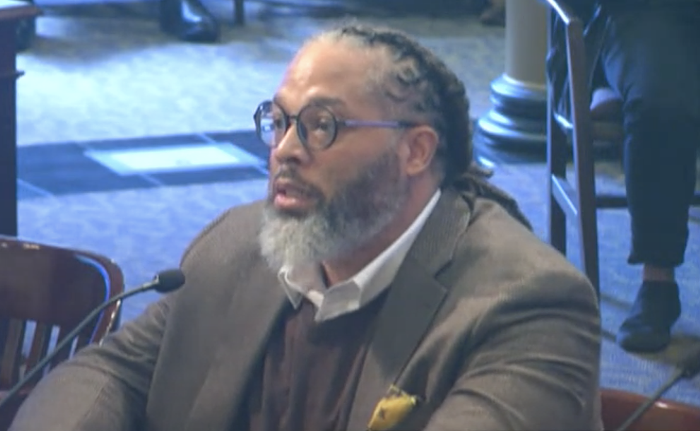"AND THEN the player gets attacked by the creatures of darkness and doom!"
"But it turns out they were praying to a false god!"
"And the only way you can be killed is by someone with a hat."
That's what you hear on the first day of a game jam. On the last day, it's more like, "Well, at least you can turn on a lamp."
In between are 48 straight hours of amateurs and professionals sprinting through the entire development cycle of a video game—albeit maybe one you wouldn't immediately recognize as a video game. Frequently broken, incomplete, or experimental, games made at game jams are to Halo or Call of Duty as free jazz is to Nicki Minaj. But with a little spit and polish, these games have gone on to receive critical and commercial success. And the video game industry—and big-name game publishers—are starting to take notice.
"I'M A STRAIGHT-UP NEWBIE," says Kora Wietrzynska. "I want to go into video games, so this was the perfect thing for me." Wietrzynska is 20 years old and originally from Pozna, Poland; with a platinum blonde crew cut and a neon pink hoodie, she represents a younger generation of artists looking to break into the industry. For her, the 2016 Global Game Jam represents a chance to rocket from "I'd love to make a game" to "Yeah, I've made a game" in a very short amount of time.
She's not alone. The annual Global Game Jam is made up of thousands of teams across dozens of countries. Various sites are set up that feature computers, snacks, and potential teammates. The Portland site I visited in January occupied a hallway of computer labs at the Art Institute of Portland, boasted a few dozen teams, and was organized by the Portland Indie Game Squad—AKA PIGSquad—a loose collective of developers and gaming enthusiasts.
No two jams are identical, but most feature a unifying theme and take place over the course of a weekend. PIGSquad provided a boilerplate schedule for teams to check their progress against: brainstorming should take no more than six hours, and a playable prototype should be done within 24. Twelve hours after that, the game should be complete.
The theme of the 2016 GGJ was "ritual," and most teams spent their first chunk of time determining how to define the word. There was an even split between "how you brew your morning coffee" and "pagan sacrifice."

- Will Corwin
Brainstorming is particularly vital because the mechanics for every game are different. When making a film, the basic rules are generally uniform: characters enter, speak, and exit; things move from beginning to end. That's not the case with game design: You might progress by pressing buttons that move a character left and right, or you might progress by playing a flute (as is the case with Tooty Flutey, one of the games produced at this jam). Even the simplest decisions require layers of planning.
"My first jam was four or five years ago, and we bit off waaay more than we could chew," says Michael Lorenzo, an industry veteran and leader of the largest team here. He's a tall, clean-cut guy with the concerned expression of a harried art teacher. At a jam, Lorenzo says, it's easy to plan more features than are possible to deliver.
Wietrzynska's on a team with a half-dozen artists and programmers working together for the first time. The concept her team has settled on is a simple one: "Your parent leads you on the rituals they perform during the day," she says, "and when they're gone, you're expected to continue those rituals." How will this be translated into gameplay? That's to be determined.
Across the room, a smaller team has taken a different approach: Their game, Rhythmica, will be about a gothy witch who weaves spells out of music. The game's illustrator is Conley Presler, a digital art technician at Milwaukie's Dark Horse Comics who looks a bit like a librarian and dresses like a librarian who lives on a spaceship. She fires up a graphics tablet and begins sketching concepts.
After brainstorming is over, the teams delegate who needs to do what: artists produce art, programmers construct the game's framework, and team leaders make sure everyone stays on track. The rest of the jam will consist primarily of people staring at computer monitors or trying to grab a few hours of sleep on the floor.

- Will Corwin
TWO DAYS LATER, there's a heady mixture of elation and despair in the room. Towers of empty pizza and doughnut boxes stand like sentries; jeans and sneakers have given way to pajama pants and slippers. The smell could generously be described as "musky." The final accounting is mostly good: Presler's team met their modest goals, while Lorenzo's squad has produced Relic Rush, a kinetic four-player fighting game.
Wietrzynska's team, on the other hand, has had some setbacks. Life of Lumby, initially conceived as a non-linear learning experience, has been reduced to a very linear exercise of "follow the leader."
"Originally it was going to be a randomized, tile-based environment," she says, which would have made each play-through unique. "Buuuuut," she mutters, "48 hours."
So instead of a dynamically changing environment, everything is flattened to a simple background with a few elements on top. "I spent the majority of the weekend," she says, "painting trees."
LUCKILY, the Global Game Jam is closer to the World Naked Bike Ride than the Olympics in terms of competition. According to Global Game Jam, Inc., the California-based nonprofit that provides the framework for each jam (and operates the website where you can find an archive of completed games), more than 36,000 developers across 93 countries created 6,800 games in 2016.
This year, many of the people I talk to (including Wietrzynska, Lorenzo, and Presler) have ulterior motives. PIGSquad's genial, ginger-bearded founder Will Lewis and former Jumpdrive Studios marketing director Corey Warning are organizing another jam, set to take place two weeks later, where the stakes will be considerably higher. Many of the developers are using this jam as practice for that one.
TWO WEEKS LATER, I'm at the site of the inaugural Cartoon Network Game Jam. It's being held on Valentine's Day weekend at Refuge, a trendy event space in Southeast Portland's industrial district. This jam feels less like being in community college and more like being at a fashionable afterparty, albeit one full of people wearing Adventure Time shirts. The computers are fancier, and the rewards are bigger: 16 finalists will walk away with $3,000 for the weekend, and at least one will get a chance to enter into a work-for-hire agreement to further develop their game for Cartoon Network.
The theme for this jam is OK K.O.! Lakewood Plaza Turbo, which is a Cartoon Network property created by Ian Jones-Quartey (Steven Universe) and Toby Jones (Regular Show), both of whom will be observing the jam and judging the results. This time, teams are capped at six, and each team is handed an envelope that contains the name and stats of an OK K.O.! character, be it Radicles (a teen dirtbag space alien) or A Real Magic Skeleton (a real magic skeleton). The goal is now to create a mobile game focused on that character in 48 hours, after which they'll have two weeks to smooth any rough edges noticed by the judges.
Alongside creative talent, this jam has merited the attention of Cartoon Network brass. Rob Sorcher is the Cartoon Network's chief content officer.

- Jam organizers Will Lewis (bottom right) and Corey Warning (top right) kick it with OK K.O.! creators Ian Jones Quartey (bottom left) and Toby Jones (top left).
- Will Corwin
"This is part of a concerted effort to reinvent our models for content development," Scorcher says. He sees this jam as a way to reach an untapped pool of Pacific Northwest creators. "Everything is led by artists," he's careful to note. "That's what supercharges these things. It's young, passionate, interested talent that's going to make this all go."
True as that might be, the danger with an event like this is that it can be easy to confuse volunteer-run creative exercises like the GGJ with mercenary "art contests" designed to churn out free marketing for giant corporations.
Presler, a longtime illustrator, has seen a number of the latter. "I'm not a huge fan of creative contests," she tells me. "But I feel pretty good about this." Alongside considerations like complimentary on-site food carts and a per diem for participants, Presler explains that an important factor here is that—excepting the specifically copyrighted OK K.O.! characters—everyone retains the rights to their underlying work.
Wietrzynska, Presler, and Lorenzo are here with their respective teams—and so are about 40 other teams, some from as far away as London. As the envelopes are handed out, each team discovers which goofy little cartoon will be dominating the next 48 hours of their lives. Wietrzynska gets Miss Pastel, a "pouty sourpuss" mean girl. Presler gets a hard-hitting news anchor. Lorenzo's team winds up with a sort of sentient Roomba.
Holding court around the room are Cartoon Network animators, artists, and showrunners from Burbank, California, and Atlanta, Georgia. In this room, they're celebrities in a way I assume is rare for professional animators, posing for pictures and offering advice.
"I've never seen anything like it," Steven Universe's Jones-Quartey tells me. "I'm really humbled by it."
DESPITE the posh setup, the second day of the Cartoon Network Jam begins to exhibit many of the familiar trappings of jam culture: The pizza boxes begin to stack. Designer jeans are traded for sweats. Some participants head home to sleep. Others roll out air mattresses and sleeping bags wherever there aren't monitors and keyboards.
After a day of work, Wietrzynska is more optimistic than last time. "All our assets are basically done," she says. "I think we're finishing up the very last touches." Her team is working on an "endless runner," a popular genre among jammers, offering a simple framework on which to place animations and models.
Lorenzo, meanwhile, is experiencing some trouble. "We're all 3D artists," he says. "There's almost no 2D artists in my group." That was a strength with his flashy brawler from the GGJ, but a liability with the flat style of OK K.O.!
The third day of the jam is for last-second details (or frantic scrambling) and assessment by the judges. Jones and Jones-Quartey move from table to table, offering compliments, notes, and gentle criticism.
"The adrenaline from the judges and the final crunch time is definitely kicking in," Wietrzynska says, sprawled out on a couch. Presler notes with relief that the judges offered little negative feedback. Lorenzo's team didn't fare as well. "Right now, everything's pretty broken," he says. "Things that were working no longer are, and we can't figure out why."
It's a disappointing result—but they've still got time. "We're not defeated yet,"Lorenzo says. "It just feels that way."
Sometime in May, the winners will be announced to the world on Cartoon Network's website. Now it's just a matter of deciding whether to celebrate, commiserate, or go home to what remains of Valentine's Day.

- Will Corwin
REGARDLESS of who wins the money, the game deal, and the prestige, this was a good showing for Portland's video game community: Every team uploaded a functional prototype, and after a few bug fixes, many of the completed games were on display at a showcase last weekend at the XOXO Outpost, a shared workspace in Northeast Portland.
"While it was rough, it was a good experience and we learned a lot," Lorenzo says of the Cartoon Network jam.
"I'd never made a game before, and now I've been a part of two," Wietrzynska tells me. She's already planning to make more.
Meanwhile, PIGSquad is planning at least two more jams this year. Which means that—even if you never play one of the inventive games made in the pressure cooker of a game jam—it might not be long until, while standing in line for your morning coffee, you overhear aspiring developers hatching bold adventures for false gods and creatures of doom.












